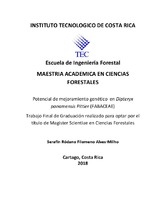Potencial de mejoramiento genético en Dipteryx panamensis Pittier (FABACEAE)
Fecha
2016Autor
Alves-Milho, Serafín Ródano Filomeno
Metadatos
Mostrar el registro completo del ítemResumen
Present research aims to determine the potential for genetic improvement in growth and WSG on Dipteryx panamensis Pittier, at 75 months provenance and progeny trial in Costa Rica. Growth in merchantable volume and WSG were estimated by fitted models and validated previously based on a 56 sample trees. DBH and Height were measured using a diameter tape and a telescopic pole while the WSG was measured from a sample of extracted wood in standing trees by a Pressler drill hole at the height of the chest, and estimated by gravimetric method according to ASTM standards D2395-14 (ASTM 2014ª). Genetic selection was done using the criteria of selection by characters growth in merchantable volume and WSG, by using the SELEGEN software 2015.
Research found that potential model for combined variable fit best for total volume, while simple generalized combined model fit best for merchantable volume. The specie in trial is growing optimally and best families reached diameters and total height higher than those found by other studies for other trials in Costa Rica. Average growth in DBH was 2.07 ± 0.45 cm, while the height growth was 2.14 ± 0.29 m. Growth in merchantable volume was 7.8 m3/ha ± 0.43.Comparing the MAI of dominant heights for trial with dominant heights for other 36 plantations, these resulting in IS curves superior to existing ones. The results of soil analysis and the excellent growth found in the trial suggest that, high performance would be function more, from the genetic material and the basic silvicultural practices carried out on it, than the site conditions.
For WSG, research found that WSG for Dipteryx panamensis Pittier, could be estimated as an accurate manner by a sample extracted with Pressler wood borer. Tree WSG could be estimated using a statistical model based on combined variable Y= b_1 〖MerchVol〗^b2*〖WSGsamp〗^b3. Average WSG obtained from 398 trees was 685 ± 0.038 Kg/m3. WSG tends to variation in axial direction and by radial direction in significative manner. The innerwood has a 20% lower WSG than outerwood. The hardwood percentage at 75 months of age could reach 3.45% of basal area. WSG also tends to variation with micro site variation.
There is significant genetic potential in the progeny and provenance trial at 75 months. It confirms the important variation within families and among families. Non significant differences were found among provenances. Superior families by merchantable volume and WSG are CSJ1, CSJ6, and 10. By using seed propagation of those families, the genetic gains could reaches 19.03% in merchantable volume and 0.96% for WSG. Whereas if you select the best individuals by only merchantable volume genetic gains reach up to 26.08%, but -0.14% in WSG. Similarly if the best individuals are selected by WSG results in genetic gains of 3.57% in merchantable volume and 2.85% in WSG. A negative Non significant genetic correlation between WSG and merchantable volume was found but there is evidence for a trade off effect between merchantable volume and WSG.
Descripción
Proyecto de Graduación (Maestría en Ciencias Forestales) Instituto Tecnológico de Costa Rica, Escuela de Ingeniería Forestal, 2016


